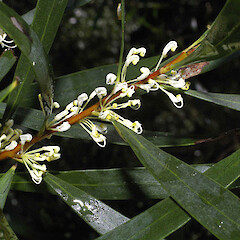Hakea salicifolia
Common name
willow-leaved hakea
Family
Proteaceae
Flora category
Vascular – Exotic
Structural class
Trees & Shrubs - Dicotyledons
NVS code
The National Vegetation Survey (NVS) Databank is a physical archive and electronic databank containing records of over 94,000 vegetation survey plots - including data from over 19,000 permanent plots. NVS maintains a standard set of species code abbreviations that correspond to standard scientific plant names from the Ngä Tipu o Aotearoa - New Zealand Plants database.
HAKSLC
Conservation status
Not applicable
Habitat
Terrestrial. A coastal and lowland plant (Timmins & MacKenzie 1995). The plant is found at sites with low fertility (Timmins & MacKenzie 1995). A plant confined to very poor soils (Timmins & MacKenzie 1995). The plant is found in low forest, scrub and forest margin, shrubland and fernlands (Timmins & MacKenzie 1995).
Wetland plant indicator status rating
Information derived from the revised national wetland plant list prepared to assist councils in delineating and monitoring wetlands (Clarkson et al., 2021 Manaaki Whenua – Landcare Research Contract Report LC3975 for Hawke’s Bay Regional Council). The national plant list categorises plants by the extent to which they are found in wetlands and not ‘drylands’. The indicator status ratings are OBL (obligate wetland), FACW (facultative wetland), FAC (facultative), FACU (facultative upland), and UPL (obligate upland). If you have suggestions for the Wetland Indicator Status Rating, please contact: [Enable JavaScript to view protected content]
FACU: Facultative Upland
Occasionally is a hydrophyte but usually occurs in uplands (non-wetlands).
Detailed description
Large erect shrub or small tree, glabrous except for silky hairs on very young shoots and leaves. Shoots angular. Leaves sessile to shortly petiolate, flattened, 60-110 x 5-15mm, narrowly elliptic-oblong or narrow-elliptic, entire, coriaceous; base attenuate; apex acute, not spiny. Flowers in fasicles of up to about 20. Pedicels 3-7mm long. Perianth white, < pedicel; limb curled back against tube. Ovary sessile; style glabrous; stigma cone large, oblique. Fruit 2-2.7 x 1.3-1.6cm, tuberculate; beak curved. Seed 15-20 x 5-7mm (including wing), black; wing extending down 1 side. (Webb et. al., 1988)
Similar taxa
Large erect shrub or tree, without hair except for silky hairs on very young shoots and leaves. Not prickly. Leaves flattened and elliptic (rounded at both ends, widest in the middle) to 110 mm long. Capdule woody with beak t 1.6 cm long, seed winged down one side. Flowers August-November. Can be distinguished from downy hakea and needlebush (prickly hakea) as it is flat leaved and not prickly. Could be confused with phyllode bearing wattles e.g. Sydney golden wattle (Racosperma longifolia) (DOC, 1998).
Flowering
August, September, October, November
Flower colours
Cream, White
Fruiting
Fruit are always present because follicles persist on tree (Timmins & MacKenzie 1995).
Life cycle
Perennial. Perennial. Seeds. No vegetative reproduction. Seed production is approximately 25 000 seeds at 15-20cm d.b.h. A seed bank is formed on trees not soil. Seed is dispersed by gravity and wind.
Year naturalised
1908
Origin
Eastern Australia
Reason for introduction
Ornamental
Tolerances
The plant is slightly tolerant of shade, highly tolerant of drought and intolerant of poor drainage. At the adult stage the plant is slightly intolerant to frost. The plant does not resprout from the base after physical damage. Fire kills the plant but serotonous seed capsules release seed if fire not severe.
Etymology
salicifolia: From the Latin Salix ‘willow’ and -folia ‘leaf’, meaning ‘willow-leaved’





